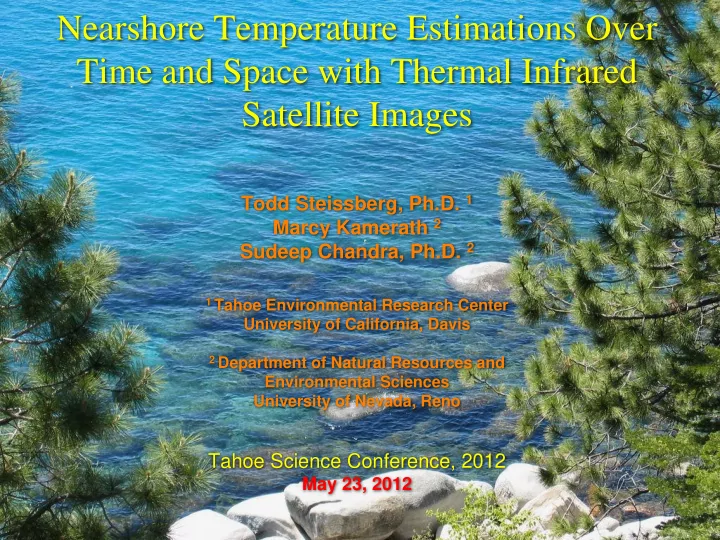

Nearshore Temperature Estimations Over Time and Space with Thermal Infrared Satellite Images Todd Steissberg, Ph.D. 1 Marcy Kamerath 2 Sudeep Chandra, Ph.D. 2 1 Tahoe Environmental Research Center University of California, Davis 2 Department of Natural Resources and Environmental Sciences University of Nevada, Reno Tahoe Science Conference, 2012 May 23, 2012
Introduction • Problem • Temperature is a major limiting factor in lakes • Influences growth, reproduction, distribution • Invasive species • Nearshore temperature information is limited • Solution • Satellite measurements can provide temperature estimations over time and space • Provide past, present, future time series • Provide cost and time-effective sampling of entire littoral zone
Introduction • Another Problem High resolution satellite sensors can “see” the nearshore but are • limited over time • 60 – 90 m pixels • 1 – 2 images/month • Moderate resolution sensors acquire sub-daily images, but the nearshore radiance is contaminated by land • 1000 m pixels overlap water and land • 2 – 4 images per day • Solution • Use sub-daily MODIS images to measure temperature indirectly • Sample offshore and predict predict/estimate nearshore
Satellite Measurements • MODIS – Moderate Resolution Imaging Spectroradiometer • Two MODIS sensors in orbit (Terra and Aqua satellites) • 1000 m spatial resolution (Thermal Infrared, TIR) • 0.5 day repeat time (each sensor, in TIR) • 2 TIR images per day per sensor, 4 total • 36 spectral bands • 6 TIR bands: 20, 27, 29, 31, 32, 35 • Bands 31 and 32 ideal for temperature estimation • High quality, low noise • Atmospheric window • Several bands can be used for QA/QC and atmospheric correction • Calibrate radiance data to water skin temperature (WST) • WST is analogous to SST, but for lakes • Skin temperature: temperature of top 0.01 – 1 mm layer of water
Offshore Skin Temperature Calibration/Validation WS, WDir Net Rad. Air Temp., RH Skin Temp. Bulk Water Temp.
MODIS, ASTER, ETM+ Comparison June 3, 2001 June 3, 2001 19:06 UTC 18:28 UTC T m = 12.3 o C T m = 11.9 o C MODIS, Actual Size June 3, 2001 June 3, 2001 19:06 UTC 06:10 UTC T m = 12.0 o C T m = 11.4 o C
MODIS Monthly WST, 2006
Satellite Temperature Data before Cloud Masking Sampled at Mid-Lake
Cloud Detection and Masking • MODIS standard cloud masking (spectral screening, threshold tests): • Band 27 • Band 31 • Band 35 • Band 20 – Band 32 • Band 31 – Band 29 • Band 31 – Band 32 • Problem • Seasonal variation • Solution • Detrend spectral test data k 1 *sin( p *abs(day + k 2 )/365.25) 4 + k 3 • • Detrend daytime and nighttime data separately
Screened Satellite Temperature Data Band 31, Day Band 31, Night Band 20 – Band 32, Day Band 20 – Band 32, Night
Screened Satellite Temperature Data
Nearshore Calibration • 20 nearshore in situ sampling sites, using iButton thermistors 50 MODIS “sampling” sites • • 50 corresponding nearshore MODIS prediction/estimation sites • Weekly averages are computed to remove diurnal variation differences • Weekly offshore WST regressed against weekly sub-surface nearshore in situ temperatures • Derived equations applied to multiple adjacent sites • Inset: regression and prediction • T Nearshore = k 1 *T Offshore + k 2
Regression: MODIS Offshore vs. In Situ Nearshore Sunnyside Taylor Creek Outflow
Coefficients of Determination
MODIS-Derived Nearshore Water Temperature Marla Bay
Nearshore Variability by Week
Conclusions • Nearshore temperatures can be predicted along the entire shoreline, providing a basis for comparing thermal regimes. • For non-native species, whose distribution or spawning activity is closely tied with temperature, this information can direct or prioritize management and monitoring to the most thermally suitable areas, earliest in the growing season. • Satellite-derived and in situ temperature results for Lake Tahoe indicate that the locations most susceptible to invasion by warm-water fishes are Emerald Bay, near Taylor creek, along the southern shoreline, and Crystal Bay (northeast). • Snorkeling surveys in 2006 and 2007 indicated presence of two non-native warm-water fish species (Lepomis macrochirus and Micropterus salmoides) in these locations • The first detections of warm-water fish species in a season occurred in these locations
Acknowledgements • Dr. Simon Hook, Dr. Ali Abtahi, NASA/JPL • Dr. Geoffrey Schladow, Brant Allen, UC Davis • Funding Sources: • Southern Nevada Public Lands Management Act (SNPLMA) • Nevada Division of State Lands • University of Nevada, Reno
Questions?
Recommend
More recommend